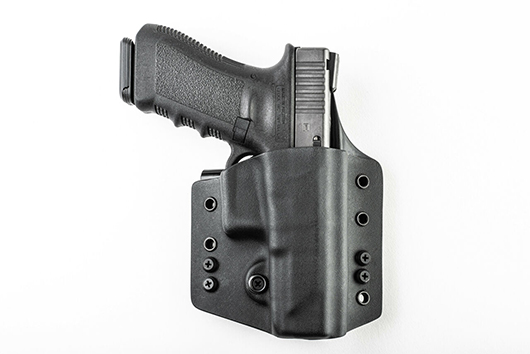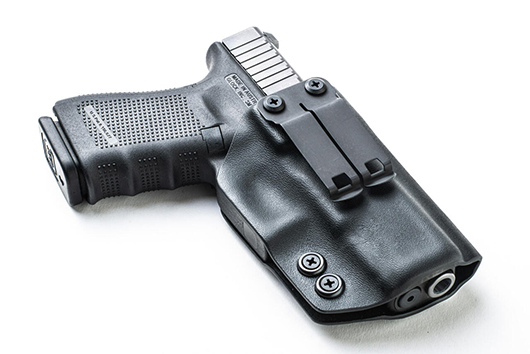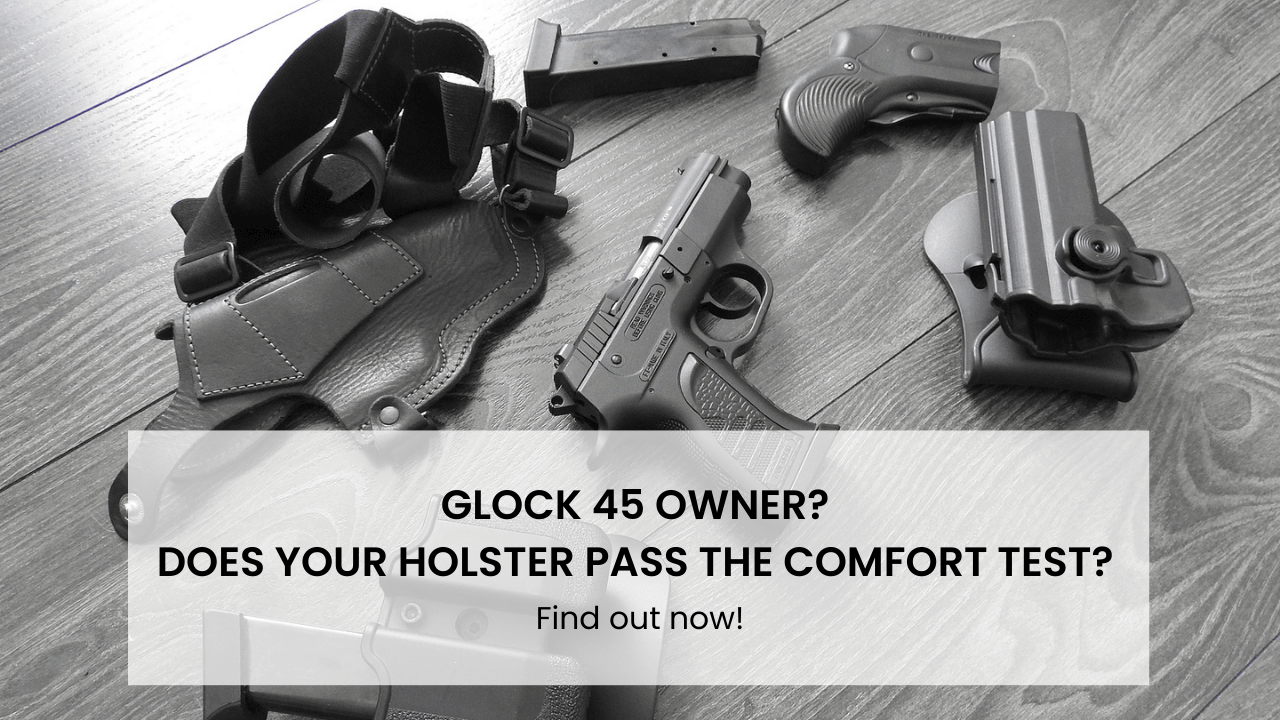What to Look for in a Glock 19 IWB Holster
Jun 3rd 2021

The Glock 19 is a compact variant of the 9mm Glock 17 service pistol, introduced by the Austrian firm in 1988. Fed from a 15-round magazine, as standard, the G19 is a popular duty, self-defense, and competitive-shooting weapon in the USA and abroad.
The Glock 19X combines the compact slide of the G19 with the full-size frame of the G17 into a Gen 5 hybrid. Regardless of the firearm that you choose for concealed carry, you need a suitable holster. If you're interested in carrying IWB, concealability is paramount.
Choosing a Good Holster
If you want to carry a gun, your holster is one of the most important accessories you can own. Not all holsters are created equal, however, so you'll have to be discerning. Knowing what selection criteria to use can help you choose the perfect holster for your specific requirements.
Comfort
Your holster rides on your belt or inside your waistband for an extended period. So choose a model that is comfortable, especially when pressed against your body. You're less likely to carry an uncomfortable holster.
Protection
A holster should adequately protect your firearm from impact, abrasion, and the elements. Kydex meets all three criteria, making it an ideal choice for gun holsters.
Retention
Retention is the system that allows the holster to secure your firearm, preventing it from being too easily drawn or falling out. This stops an unauthorized user, such as an assailant, from accessing your firearm in an attempt to disarm you, increasing the security of carry. Furthermore, when running or performing other strenuous activities, retention ensures your handgun remains securely by your side at all times.
Concealment
Your priority when selecting a concealed carry holster should be concealment. Does the holster conceal your firearm under your clothing? How concealable your holster is depends on several factors, including how you dress.
Trigger Coverage
As a rule, a high-quality holster, whether IWB or OWB, should fully cover the handgun's trigger, preventing your index finger from entering the trigger guard until you complete the draw stroke and the gun is free.
Positive Grip
Whatever holster you select, the acquisition of a full firing grip during the draw stroke is essential.
Want Maximum Concealment?
A concealed-carry holster's purpose is to enable you to carry your firearm discreetly. To maximize concealability, there are certain accessories and features you should look for.
Holster Claw
A holster claw is a device designed to hold your holster close to your body. Although dependent, to an extent, on your choice of gun belt, the object is to minimize printing.
Adjustable Ride & Cant
The ride height of your holster determines how high or low it sits in relation to your waistband. The cant determines the angle of rotation. As the handgun cants forward, the grip rises. Fifteen degrees of positive cant is common. The butt of the pistol is a common source of printing; therefore, a positive angle increases concealment. A negative angle, however, reduces the space between the grip and the belt.
Adjustable Tension
Ideally, a passive-retention holster should have adjustable retention. By tightening or loosening one or more screws, you can determine how firmly or loosely you want the holster to grip your gun.
Lightweight Genuine Black Kydex®
Kydex is an impact-, scratch-, and moisture-resistant thermoplastic used in a wide variety of tactical and industrial applications, from handgun holsters and knife sheaths to aircraft interiors.
Protective Sweat Guard
A sweat guard also called a sweat shield, is the part of the holster that sits between the gun's slide and your body. If it extends upward to cover the slide, it has a full sweat shield. This protects the gun from corrosive perspiration and your skin from heat.
Audible "Click" on Holstering
Passive-retention holsters that use Kydex lock the gun at one or more points, such as the trigger guard and slide. When you return your weapon to the holster, you'll often hear an audible "click," indicating that the weapon is fully seated and secure.
Types of Holsters
The holster type you should choose will depend on various factors, such as your preferred method of carry, position, manner of dress, and model of handgun.
IWB (Inside the Waistband) Holsters
Inside-the-waistband holsters (IWB) are designed to be worn between the body and the waistband. This allows for maximum concealment. IWB holsters typically use belt clips to attach at one or more points.

OWB (Outside the Waistband) Holster
Outside-the-waistband holsters (OWB) are designed to be worn on the outside of the waistband, attaching to the belt via loops. While more comfortable than IWB holsters for many users, OWB holsters require a cover garment, such as a jacket, to conceal effectively. OWB holsters, however, are ideal for open carry.
Appendix IWB (AIWB) Holsters
Appendix carry holsters position the handgun at 11, 12, or 1 o'clock, allowing for increased concealment and a rapid draw stroke. However, due to the direction in which the gun's muzzle is pointed in this carry position, you must exercise caution when drawing and reholstering your firearm. Appendix carry contrasts with strong-side carry, in which you carry the gun on or behind your dominant-side hip. If you're left-hand dominant, this is your left hip.
Holster Materials - Leather vs. Kydex vs. Hybrid
While handgun holsters are available in a variety of single materials, there are those made from two or more. These are called hybrid holsters. The purpose of a hybrid holster is to provide the precise tolerances, strength, and environmental resilience of Kydex with the comfort and finish-protecting texture of leather. While these hybrid holsters offer excellent function, they also tend to experience inconsistent wear.
Leather Holsters: Pros & Cons
Leather is a popular material for waistband holsters and knife sheaths because it's relatively soft, comfortable, and aesthetically pleasing. Leather can also mold to the contours of your body. However, a classic leather holster is also susceptible to moisture, warping, or deteriorating when wet. As leather is highly pliable, it can lose retention over time due to harsh use.
Kydex Holsters: Pros & Cons
Kydex holsters and mag carriers are popular choices among those interested in concealed carry. Kydex is durable, resistant to the elements, and rigid. On the downside, Kydex is harder than leather and may not be as comfortable to wear for prolonged periods. It can also cause wear to the gun's finish.
Nylon & Cordura Holsters (Avoid Unless You're Broke)
Nylon and Cordura holsters are inexpensive and readily available. However, unless you're on a strict budget, you should generally avoid holsters made from these materials. Nylon doesn't provide the same retention level as either leather or Kydex and can fray from regular use. As a result, nylon holsters typically use an active-retention system, such as a snap closure.
Parting Thoughts
At Incognito Concealment, high-quality Kydex holsters are our passion. We manufacture holsters to fit a wide variety of firearms, including the popular Glock series of handguns. If you want to discuss holsters with us or place an order for one of our quality concealment holsters, give us a call. We'd be happy to help you find the best concealed carry holster for your needs.
FAQs
Is a Glock 19 good for concealed carry?
The Glock 19, being a compact handgun, is a superb weapon for concealed carry. Although not as compact as the subcompact Glock 26 and 43, the G19 prints less than its full-size counterpart thanks to its shorter grip.
Will a Glock 19X fit in a Glock 19 holster?
A holster designed for the Glock 19 is also compatible with the Glock 19X. The primary difference between the G19 and the G19X is the length of the grip, which is the same as a Glock 17. The slide, however, is the same; therefore, it will fit snugly in the holster pocket.
Is the Glock 19 too big for appendix carry?
For many shooters, the Glock 19 is perfectly sized for appendix carry, allowing the pistol to lay against the abdomen, hidden by the cover garment. However, whether the Glock 19 is too big for you depends on your body type. This also affects the viability of appendix carry in general.











